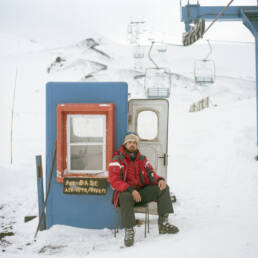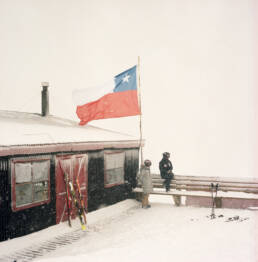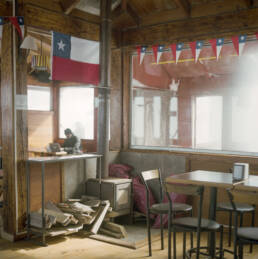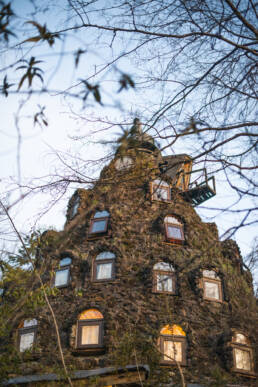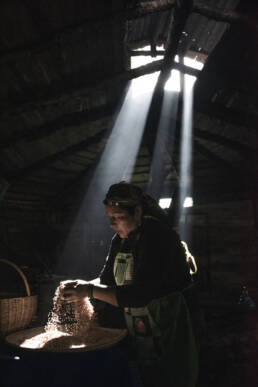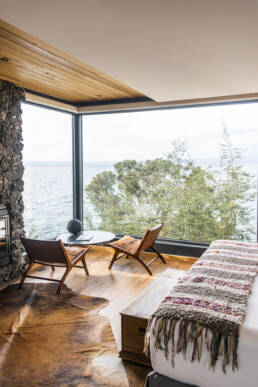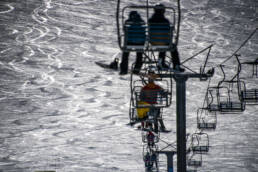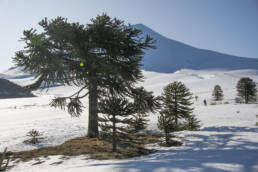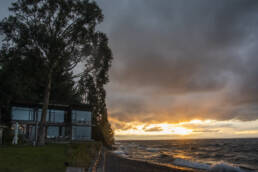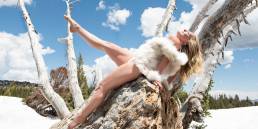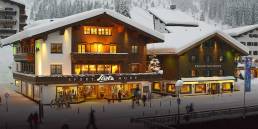Spring in South America offers the chance not only to climb and ski volcanoes—but also to explore a world-away winter culture.
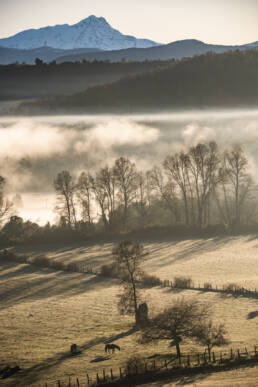
When Portuguese explorer Ferdinand Magellan hit landfall near the tip of South America in 1520, he encountered giants – or so he thought. He called them Patagones, derived from the word for “paw” in his native Portuguese. Perhaps it was the effect of scurvy or too much time at sea, but some accounts had them reaching heights of 14 feet. These early explorers did get at least one thing right: the land that would become known as Patagonia is a place where hyperbole and the imagination run wild.
“Patagonia has come to say ‘hi’ today,” Guido Schilling, our guide, shouts cheerfully into a freight train of a wind threatening to strip us from the slopes of Volcán Casa Blanca, one of dozens of volcanoes in the seismically restless Lake and Volcano zone, 600 miles south of Chile’s capital Santiago. Some, like Casa Blanca, are extinct. Others, like Volcán Osorno, are dormant, puffing steam from fumaroles and slumbering until their next violent reawakening.
A half hour ago, we had scrambled to gear up in the base lodge of Antillanca, a club-owned ski resort with 3,000 members. Inside the lodge, junior racers from Chile and Argentina, here for the Patagonian championships, were crushing a buffet of chicken and rice. Outside, skies were calm as we rode up the antiquated double chair. Things changed as soon as we skinned up a ridgeline beyond the summit T-bar. A dense mist had cleared but a tempest suddenly snarled up from the south – a storm that would have billowed the sails of Magellan’s flagship, Concepcion.
“It must be more than 120kmh,” Guido yells out, his internal anemometer precisely gauging the wind speed.
Surrendering to the absurdity of the outing, I stop moving and lean as far as I can into the wind without falling over, convinced that I’m tilted at a 30-degree angle.
Born in Switzerland, Guido traveled to this region with a backpack almost 30 years ago, fell in love with the landscape, then fell in love with a woman. It’s easy to understand why he stayed—the natural order of things, I suppose—especially for someone from the cloistered and tidy world of Switzerland. There’s something wild and alluring here—the crystalline rivers, the hot springs, the endangered Araucaria Araucana monkey puzzle tree so sacred to the indigenous Mapuche people, the asados of meat large enough to induce cardiac arrest simply through the act of reading the menu, and towering volcanoes that are magnets for snow despite the molten heat that bubbles within.
Of course planting a seed is not enough to grow ski culture—it needs to be watered and nurtured. Guido and our local fixer Cristian Levy, the gregarious owner of Amity Tours, told us there was someone we had to meet, someone who understood the magic of winter in a land of volcanoes. In this regard, Jose Cordova Salazar is “a legend,” Cristian assures us. We find the 77-year-old, affectionately known as Tio Pepe, further north at his home in Malalcahuello, rummaging around in a workshop full of old skis and poles. He wears the fur hat of a Cossack and his face crinkles warmly when he smiles and offers a strong hand to shake.
Following introductions, we head to Endemiko, a restaurant with a cool, modern feel that seems a tad ahead of its time in this rustic mountain community. Jose Herrera, who co-owns the eatery and adjoining boutique hotel with his dad, spent a few seasons in Whistler before returning to Chile to get serious and start a hospitality business in his hometown.
We sit down to a Chilean feast of melt-in-your mouth beef tenderloin, a bottle of Carménère (a varietal of French origin that Chile rescued from obscurity and now proudly claims as its own) and enough stories to fill a bible of skiing. Tio Pepe arrived in this village at age 35, fresh from military service. He had wisely opted for the mountain military unit and, for Tio Pepe, it sounded like an adventure camp for young adults, learning to ski and climb in the mountains around Portillo. Though snow piled deep around Malalcahuello, to his surprise most locals viewed winter—and snow—as a necessary burden, like paying taxes. It was a sacrilege to him. So, he decided to do something about it and show kids the joy of sliding across snow. Sounds simple enough, but it wasn’t.
“There was so much potential here for skiing with Lonquimay,” he says, referring to the nearby, perfectly symmetrical volcano. “I had to change the mentality of the people, but it took a while.”
Tio Pepe scrounged together ski gear and eventually coaxed students to hike up a rough road, skis, and gear on their backs, to ski on Lonquimay. They would sleep in snow caves and cook with camp stoves for a few days at a time. It was character-building, to say the least, and it made an impact.
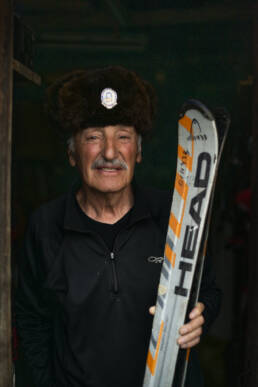
“The parents thought I was crazy,” he says with a shrug, adding that some of those students, now in their 40s, still come back to visit him.
It was the tenacious Tio Pepe who urged local government officials to fund a Poma lift on Lonquimay back in 2000. Private interests stepped in soon after, adding modern lifts and the luxury Corralco Valley Hotel and Spa set in a forest of monkey puzzle trees a few minutes’ drive from the day lodge.
Following an evening full of local ski lore, we drive up the gravel road to Corralco, the closest thing to a destination ski resort in this part of Chile. I imagine Tio Pepe and his youthful charges making the same journey, decades ago, on foot. We head to the hotel for double espressos, giving the spring sun time to soften the snow for our ascent of Lonquimay. A family of astonishingly attractive Brazilians lounges nearby in their Cordova ski attire, the teenagers glued to their Smart phones and looking as though actual skiing is a remote possibility.
Not for us—skiing is paramount. James Ackerson, the fun-loving general manager of Corralco, is happy to meet us at the day lodge. This American ski-industry vet spent two decades chasing the endless winter. He started his journey teaching skiing at Sugarbush before working his way up to VP of Skiing at Heavenly Valley.
“Corralco is a ski resort in its genesis,” he tells us. “After years of taking other people’s positions, it’s great to be here from the ground up.”
While riding the Coloradito Quad, we spot Tio Pepe arcing artful stem christies on the fresh groomers, sporting his trademark Cossack hat. Two lift rides later, we’re slapping skins on the skis. A 35-degree planar slope angles toward Lonquimay’s classic catered summit. A half dozen other adventure skiers are ahead of us, capitalizing on a bluebird day to tag the summit. I’m feeling the foggy effects of a few too many glasses of Carménère. It’s time to get the chores done.
Lonquimay rises to 9,400 feet near the northern border of the Geoparque Kütralkura. (Elevation, of course, is a fluid concept when it comes to volcanoes.) Geopark status is a UNESCO designation that, while inferring no special protection, celebrates unique geology. This area of Chile is one of the most volcanically active places in the world, one where indigenous culture is in large part defined by their relationship with volcanoes. The most powerful deity of the Mapuche, Pillan, is the god of thunder and fire. He watches over the wellbeing of the people but, at times, is prone to a ferocious temperament.
It’s a disconcerting thought, as we switchback up a mountain that could rumble to life at any moment. Even more troubling is the map of the Geoparque that I had the misfortune of looking at last night. It highlights, in blood red, the areas of alto peligro (high danger). Lonquimay is one of those places. But today, the giant seems docile.
Soon we are basking on the summit, naming volcanoes that pierce the skyline around us—including Volcán Mocho, our next skiing objective. Together we drop into Lonquimay’s sweeping south face, on corn snow as tender as last night’s beef. Halfway down, Guido stops and leans on his poles. Lonquimay means “headless” in the language of the Mapuche. On December 25, 1988, an eruption exploded from these slopes, raining ash on the surrounding countryside and triggering a six-mile lava flow that forced the evacuation of 800 people. Last night, Tio Pepe told us how the windows of his schoolhouse were blown out by the force of the eruption. The cataclysm left behind what locals respectfully call the Christmas Crater.
“There it is,” Guido says pointing a ski pole at a wind-scoured rock rim just outside the ski area boundary and still far below us.
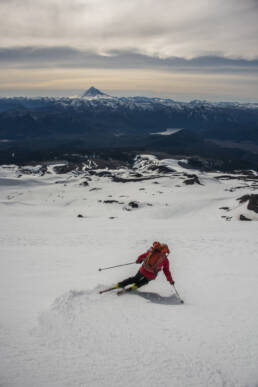
Twenty minutes later, we’re back in-bounds, turning on tame groomers with the Brazilians and other tourists. There’s no sign of Tio Pepe.
It’s hard not to be impressed by this local skiing pioneer—and what one modest, dedicated human did to change a few lives and nurture a winter-sports culture where before there was none.
And on the other hand, we have Victor Petermann, exemplar of all that big money can do in a vast land like Chile. This mining magnate owns nearly 400 square miles of mountains and forest, sandwiched between Lago Pirihueico and Lago Maihue. Through his Huilo Huilo Foundation, Petermann funds (among other projects) the conservation of huemele—the endemic deer hunted to near extinction—at a sanctuary in a verdant valley below Volcán Mocho. Though hospitality was not initially on the reclusive billionaire’s mind, his more sociable daughters talked him into building a hotel. But not just any hotel. Huilo Huilo is where building codes and design conventions go to die.
Late one afternoon we roll into the reception at Hotel Nothofagus, built on stilts in a tract of Valdivian rainforest and spiralling upwards to a summit suite.
“This place is wild, I love it,” our fixer Cristian says, as we enjoy welcome Pisco sour cocktails while the bellhops shoehorn our ski gear into a tiny elevator befitting a Parisian pied-à-terre.
Even wilder is the original hotel next door, Montana Magica. Water erupts from the summit of this volcano-inspired building and cascades down through the moss and trees that grow all over the structure—a living building that must keep an army of maintenance workers busy full-time.
Over dinner that night, we learn Señor Petermann’s private ski hill is closed for the season. However, the amenable hotel manager—a bit of a volcano-skiing enthusiast himself—quickly facilitates a dawn patrol strike on Volcán Mocho.
In blackness of the pre-dawn, we’re soon bumping up a rough road aboard a Toyota Hilux. As we gain elevation, the forest transforms from springtime green to midwinter white. Twelve-foot snowbanks line the road where our driver parks, next to a one-room ski lodge. He steps out of the truck and into the cab of a Piston Bully, firing up the diesel engine and coaxing it to life in the morning chill. We jump in the back with our gear and lurch forward, climbing to where the forest thins into alpine. Just beyond the treeline, the snowcat stops abruptly.
“This is as far as I’m allowed to take you,” the driver says, nodding at an invisible line in the snow marking the boundary of Mocho-Choshuenco National Reserve. Beyond this point, Petermann’s extravagances are not welcome.
A faint purple glow on the eastern horizon hints of sunrise. The snow is hard, making me wish I had brought ski crampons. We move quietly, each of us in our early-morning minds, following the beam of headlamps. The morning sky at our back is stunning, metamorphosing to mauve, to pink, and finally a blazing orange.
The vertical feet go quickly. We pause below a wall of hard snow, too steep to ascend on skis. The final 500 feet we climb with crampons on our boots and skis on our back. Another Patagonian tempest awaits us at the summit, a wind suddenly conjured from the sky and now strong enough to blow unattended gear—skis and poles included—into the abyss.
“Vamanos,” says Guido, clearly anxious to vacate the exposed perch.
Wind has a way of manufacturing tension. It claws at the nerves. Skins off, we glide into a shallow crater, traverse, then stop at the top of the headwall. It’s a dreamy view, a freeskier’s playground groomed by a natural terrain park of wind scoops, funnels, and rolls—all ours in the dawn of a spring morning. The headwall feels steep and unforgiving.
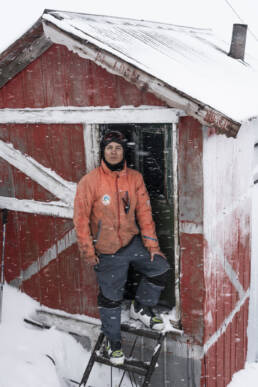
A fall here would make for a long slide, so I ski tentatively at first, warming up the legs and tuning the brain to big-mountain exposure. Where the angle relents, the terrain gets more playful and varied, and I enter that wonderful Zen state of interpreting a mountain for the first time.
Later that day, with Chilean volcano ascent-and-descent #4 in the bag, our Huilo Huilo hosts shuttle us across Lago Pirihueico. The water is mirror smooth. Densely forested mountainsides soar from the lakeshore to hidden summits. Where a creek drains into the lake a small delta has formed, with a semi-circle beach of soft sand. The roofs of buildings are visible through the trees, indicating Termas del Lago, Petermann’s hot spring retreat for family and hotel guests only. Soon I’m lying in the hollowed-out trunk of a massive beach tree, like a dugout canoe filled to the brim with water heated by the earth’s molten underbelly. It feels like my own personal private pod of hot-spring pleasure, if just for a few hours. Next stop on this skiing road trip: Volcán Osorno. Maybe we’ll see giants. Around here, anything seems possible.
Related Posts
December 11, 2019
Fast Forward-Lindsey Vonn Article & Photoshoot
What Lindsey Vonn has been up to since…


